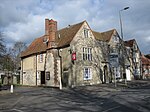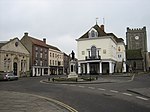Wallingford railway station (England)
1866 establishments in EnglandFormer Great Western Railway stationsHeritage railway stations in OxfordshirePages with no open date in Infobox stationRailway stations in Great Britain closed in 1959 ... and 3 more
Railway stations in Great Britain opened in 1866Use British English from March 2020Wallingford, Oxfordshire

Wallingford railway station is a railway station serving the town of Wallingford. It is now part of a preserved railway.
Excerpt from the Wikipedia article Wallingford railway station (England) (License: CC BY-SA 3.0, Authors, Images).Wallingford railway station (England)
Tudor Close, South Oxfordshire Winterbrook
Geographical coordinates (GPS) Address Nearby Places Show on map
Geographical coordinates (GPS)
| Latitude | Longitude |
|---|---|
| N 51.5978 ° | E -1.1352 ° |
Address
Tudor Close
OX10 9GP South Oxfordshire, Winterbrook
England, United Kingdom
Open on Google Maps








